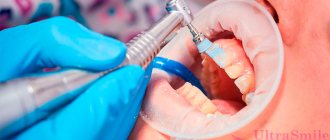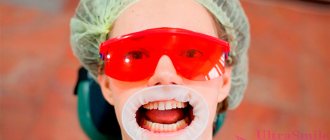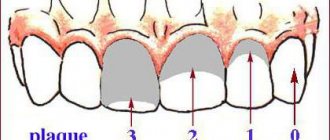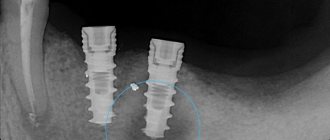Modern methods of professional teeth cleaning are safe and comfortable for the patient. The procedure can be performed even during pregnancy.
Complex cleaning is practically painless; in very rare cases, anesthesia is required. Removal of hard dental deposits and soft plaque is carried out in several stages:
- Tartar removal. First, all hard dental deposits are removed. The procedure is carried out using ultrasound.
- Cleansing using the Air Flow device. Under the influence of water pressure containing abrasive particles, tooth enamel is not only cleaned of soft plaque, but also whitened to its natural shade.
- Polishing. After brushing, the surface of the teeth becomes slightly rough, which will contribute to the rapid accumulation of plaque. To avoid this, the tooth surface is treated with special discs and bristles. After the procedure, the enamel becomes smooth and protected from the effects of pathogenic microflora.
- Treatment with antiseptics. To prevent the spread of infection and to prevent gum inflammation, the oral cavity is treated with an antiseptic solution.
- Fluoridation. After cleaning, the teeth are coated with fluoride varnish to strengthen and reduce the sensitivity of the enamel.
- Applying therapeutic bandages. In case of severe gum inflammation and periodontal bleeding, special therapeutic dressings are applied. The dressings may contain antiseptics, antiviral drugs, and antibiotics.
Inflammation after cleaning
The main cause of inflammation is increased sensitivity of teeth and gums. Increased sensitivity may be an individual characteristic of the patient's body, or it may be a consequence of gum pathologies such as gingivitis, periodontitis or periodontal disease. Sometimes the cause of discomfort can be deep tartar, the removal of which caused inflammation. If you follow all the hygienist’s recommendations, the discomfort will disappear within a few hours after the procedure.
Also, the causes of inflammation after brushing can be an incorrectly selected toothbrush and toothpaste, as well as injury to soft tissues due to careless brushing of teeth. That is why it is very important to follow all the specialist’s recommendations. After brushing the teeth, the hygienist shows the patient how to brush their teeth properly. In addition, the doctor selects a brush, paste, dental floss and additional oral care products that are suitable for the patient.
Causes of toothache
If your teeth were completely healthy before the planned cleaning, after the hygienic procedure they practically do not hurt, although now it is rare to find a person whose dental condition can be considered impeccable in all respects. Many people have caries, there is increased sensitivity due to tooth enamel that is too thin or affected by some disease, and many other dental problems.
During the process of professional cleaning, painful teeth will certainly be disturbed, which will result in their increased sensitivity and, consequently, the patient will experience pain for some time while talking or eating. Moreover, during the hardware cleaning of diseased teeth, when they are exposed to powder compounds, during the polishing process, the patient will experience very unpleasant sensations, comparable to “live” dental treatment.
The salvation is local anesthesia, which will eliminate pain both during the process of the specialist performing each of the stages of cleaning, and for the first time after completion of the procedure. However, after this a person runs the risk of encountering a problem such as severe toothache, therefore, in order to prevent such a situation, it is better to carry out preliminary treatment of the oral cavity, and only then begin cleaning.
The unprofessionalism of the dentist can also cause pain after brushing your teeth, since manipulations performed illiterately or incorrectly can damage tooth enamel. This leads to increased sensitivity and the development of caries, and to avoid such a problem, we recommend contacting the specialists of our clinic, who have many positive reviews and are attentive to each of their patients, trying to choose the optimal way to cleanse the oral cavity of plaque and tartar with the least undesirable consequences .
Rehabilitation after the procedure
To prevent gum inflammation from starting after the procedure, and for the results to last for a long time, the patient is required to properly care for the oral cavity.
What is required from the patient:
- Do not consume coloring foods and drinks for the first 24 hours after the procedure. These products include: colored fruits, vegetables and berries, coffee, red wine and natural juices.
- Immediately after the procedure, do not drink too hot or cold drinks.
- Immediately after brushing, replace the old toothbrush with a new one.
- Not only use a toothbrush twice a day, but also use dental floss and irrigator at least once a day.
- Be sure to visit your dentist every six months for a routine preventive examination.
- Do not neglect professional teeth cleaning, undergo the procedure regularly according to the indications of a specialist. As a rule, doctors recommend undergoing a comprehensive cleaning twice a year.
Ultrasonic teeth cleaning: features
As mentioned earlier, ultrasonic teeth cleaning is carried out using special dental equipment - an ultrasound scaler. The device is capable of generating ultrasonic waves, under the directed influence of which hard dental deposits are destroyed. The power of the device and the frequency of the waves are regulated by the doctor, which makes it possible to increase the effectiveness of the procedure and ensure that patients endure it as comfortably as possible.
Professional teeth cleaning, including ultrasonic cleaning, allows you not only to remove all types of dental plaque, but also to lighten the enamel by 1-2 tones. This occurs due to the return of teeth to their natural shade and the complete elimination of plaque, which may be invisible to the naked eye, but at the same time change the color of the enamel.
Well, now that we have briefly examined the mechanism of action of ultrasonic teeth cleaning, it’s time to move on to the main question: why do teeth hurt after ultrasonic cleaning?
What to do if brushing your teeth hurts?
The first step is to determine the cause of hypersensitivity with the help of a dentist. If no dental diseases are detected, the doctor will recommend effective ways to combat hypersensitivity.
Here are some tips to help relieve pain at home:
- If possible, eliminate triggers. Eat less sweets and sours, make sure the food is at a comfortable temperature.
- Use a desensitizing paste. The components contained in it dampen hypersensitivity by filling microchannels in dentin. The method of using this paste is different from what we are used to. It is squeezed onto a brush, onto a finger or a piece of cotton wool, after which it is carefully and evenly applied to the surface of sensitive teeth from all sides. The procedure is usually performed before bed; there is no need to rinse your mouth after it so that the active substance penetrates the dentin tissue. The pain when brushing your teeth will become less pronounced or disappear completely after several weeks of regular use of the desensitizing paste.
- Use a fluoride rinse or gel once a day. These agents also reduce sensitivity.
- Choose a toothbrush with soft bristles and do not apply too much pressure. Many people believe that the harder you press on the brush, the better the cleaning result will be. But strong pressure and very hard bristles over time thin the tooth enamel and make the teeth more vulnerable and sensitive to any impact. A brush with soft bristles gently affects even thin enamel, effectively and carefully removes dirt without causing discomfort.
- Take good care of your mouth. One of the causes of hypersensitivity may be poor hygiene. If you brush poorly, bacteria remain on your teeth, plaque and acid form, which irritate your teeth. Therefore, it is important to properly and regularly care for your oral cavity. It is necessary to brush your teeth twice a day with a high-quality brush, clean the interdental spaces with dental floss or an irrigator, remove plaque from the tongue and cheeks, and use a special mouthwash.
All these measures will help reduce tooth sensitivity and improve quality of life.
Sometimes your teeth start to hurt when brushing after a visit to the dentist. Procedures such as bleaching and professional cleaning can increase sensitivity. To avoid this, dentists recommend preparing for the procedure in advance by treating your teeth with a desensitizing paste. And after whitening, you need to follow the dentist’s recommendations for several days. It is not recommended to carry out such procedures more than once a year.
Treatment of inflammation
If gum inflammation appears solely as a result of professional teeth cleaning, several simple ways can reduce the negative manifestations:
- Do not eat rough foods within 24 hours after cleansing.
- For 12 hours, exclude drinks that stain the enamel - coffee, wine, natural citrus juices.
- Immediately after cleansing, avoid drinking too hot or cold drinks for 2-3 hours.
- When you get home, immediately replace your old toothbrush with a new one and do not use it for more than 3 months.
- Visit your dentist every six months for an oral exam and professional cleaning.
If your gums hurt for more than a day after professional cleaning and the discomfort does not subside, it may be caused by some kind of complication. If you have a long-term pain attack, be sure to visit the dentist.
Before visiting a specialist, painful sensations can be relieved with the help of painkillers and anti-inflammatory drugs.
What is a dental hygienist?
A dental hygienist is a specialist with a higher or secondary specialized education who has received the specialization “Preventive Dentistry” or “Dental Hygienist”. This is a doctor who professionally knows all aspects of proper oral care.
Responsibilities within the competence of a dental hygienist:
- preventive examination, assessment of the condition of the oral cavity;
- primary diagnosis of periodontal and dental diseases;
- drawing up an individual oral care program;
- providing assistance in selecting dental hygiene products;
- teaching patients how to care for orthodontic and orthopedic systems;
- choice of technology and removal of dental plaque;
- polishing minor defects (irregularities) of fillings;
- strengthening enamel with special pastes;
- explanation of the rules for brushing teeth;
- Providing consulting assistance in their specialization to dentists of other profiles.
Why do you need professional teeth cleaning?
Diligent oral care does not exclude the formation of tartar, pigmentation and plaque. Everything that remains on the teeth after hygiene procedures mineralizes over time, forming hard particles. They hold on so tightly that it is not possible to remove them with a thread or brush.
Professional sanitation is carried out using different methods. It is impossible to say for sure which teeth cleaning is better. When choosing a method, the following factors are taken into account:
- oral health;
- the presence of pathological processes;
- contraindications to the use of a particular technique;
- availability of consumables in the clinic.
The importance of the procedure is to prevent the development of the carious process. It is the stone formed on the enamel that damages the bone tissue. This leads to tooth decay. Among other things, the pathology quickly spreads to neighboring units.
Many people are interested in how often to brush their teeth. It is enough to visit the dentist for high-quality oral hygiene twice a year. If you have problems with your gums, it is recommended to make an appointment for cleaning once every 3 months.
What the procedure provides:
- enamel whitening, dark stain removal;
- cleaning from mineralized deposits and dense deposits;
- prevention of caries, inflammatory gum diseases, including you may not need further treatment of periodontitis;
- preparation for complex dental treatment (fixed dental prosthetics, implantation, bite correction);
- eliminating unpleasant odor coming from the mouth.
Treatment and prevention measures
To reduce the risk of developing hyperesthesia, fluoridation is carried out after professional hygiene with the removal of tartar. Procedure:
- saturates the enamel with useful substances that help strengthen it and restore its structure,
- reduces the likelihood of developing caries.
To avoid enamel hypersensitivity after removing tartar, you must follow the following rules:
- do not eat or drink for two hours after the procedure,
- give up solid and rough foods for a day,
- use a toothbrush with soft bristles,
- Use mouth rinses regularly.
To maintain healthy teeth and gums, professional hygiene with the removal of soft bacterial plaque and tartar should be carried out twice a year.










